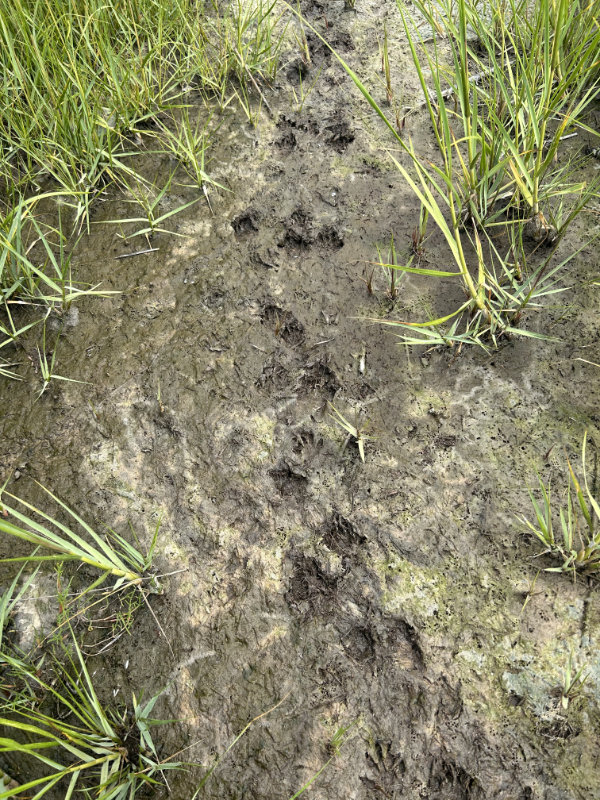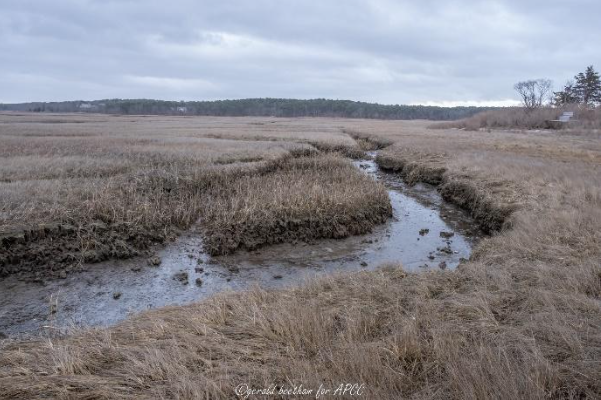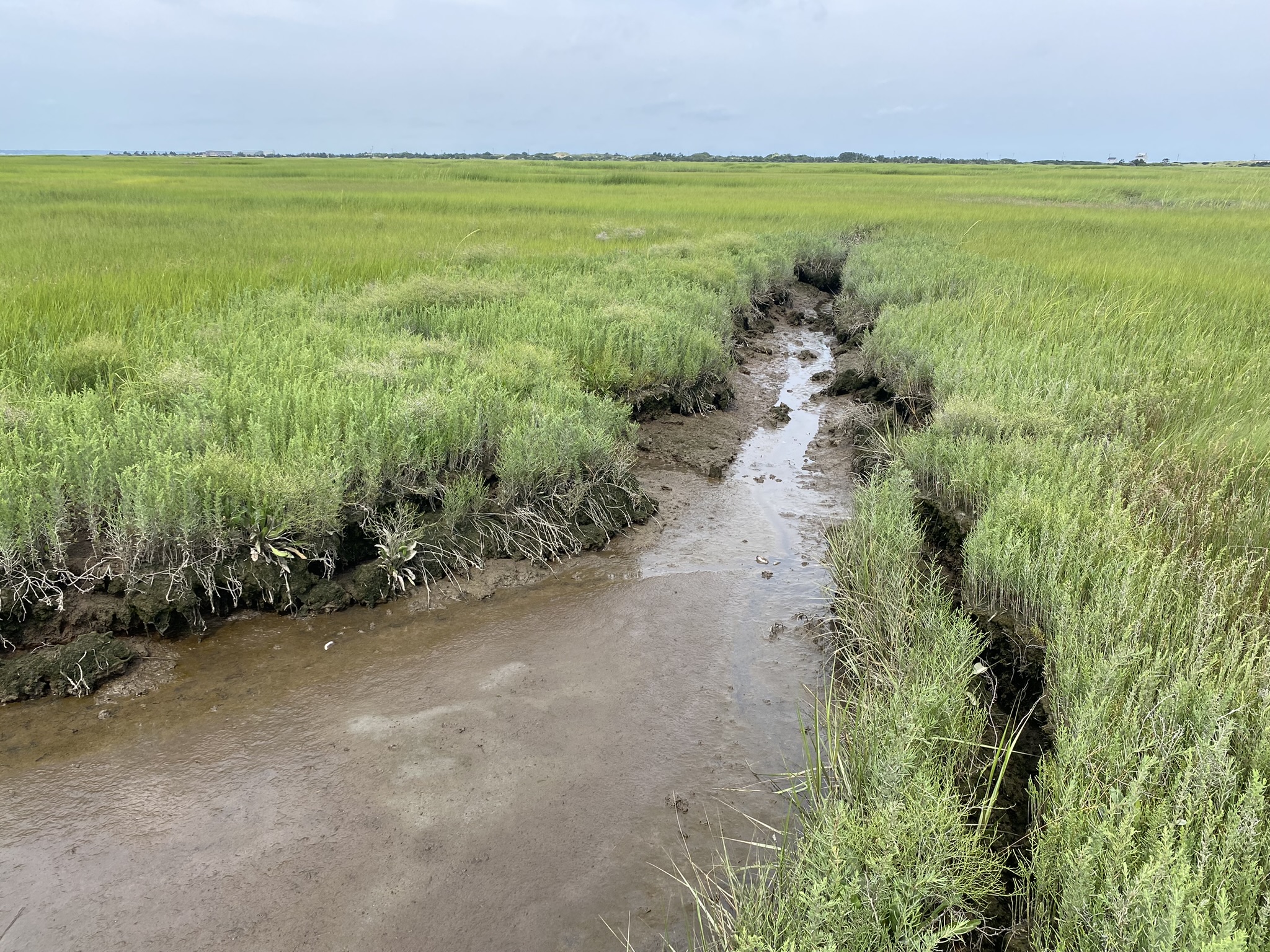Chase Garden Creek
Through the generous donation of the Lavori Sterling Foundation, APCC is assessing the current status and sea level rise vulnerability of the Chase Garden Creek salt marsh. This site includes roughly 1500 acres of salt marsh habitat, which provides shelter and food for numerous wildlife species including the threatened or endangered species listed below. While visiting the site, evidence of the marsh inhabitants is hard to miss.
Threatened/Endangered Species
Animals
- Juvenile Winter Skate (Leucoraja ocellata)
- Salt marsh sparrow (Ammodramus caudacutus)
- Eastern spadefoot toad (Scaphiopus holbrookii) *
- Diamondback Terrapin (Malaclemys terrapin)
Plants
- Mitchell’s sedge (Carex mitchelliana)
* This species is found in the dune habitat bordering the salt marsh.

The salt marsh also provides other important ecosystem services that protect the coastal community in the face of climate change. These critical services include carbon sequestration (storing carbon dioxide that’s taken up by the plants through photosynthesis as fibrous peat in the soil) and buffering storm impacts (i.e., preventing flooding and coastal erosion). These salt marshes also enhance our coastal economy by providing nursery habitat for commercial fisheries as well as offering places of high aesthetic and recreational value.
Unfortunately, the Chase Garden Creek marsh has already started showing signs of degradation and erosion at the lower elevations. The APCC assessment is part of a five-year project to identify vulnerable areas and set target goals for restoration.


YEAR 1 (2023): Marsh vegetation assessment
APCC combined two different methods of assessing salt marsh health and integrity:
GIS-based, landscape scale investigation to determine areas most impacted by ongoing sea level rise.
In-situ rapid evaluation using plant community composition as an indicator of marsh integrity.
APCC used the UVVR results to inform the locations for further study in the field. In July 2023, APCC conducted a rapid assessment (MarshRAM, Kutcher et al. 2022) whereby the relative length of a transect within specific plant community types were used to calculate a marsh integrity score.
APCC combined these methods because they consider marsh health at different spatial scales for a more comprehensive understanding of the marsh and how it has changed and will change over time. Both methods are based on the premise that a salt marsh’s capacity to adapt to climate change is determined by its biological and physical structure (i.e., elevation, vegetation, and hydrology). Where that biological and physical structure has been undermined by human practices (current and historical), the marsh cannot keep up with the compounding effects of sea level rise and other environmental stressors (e.g., excessive nutrients, storm surge, increasing temperatures, fluctuating groundwater levels, etc.).
APCC hosted a presentation and discussion via Zoom on November 14, 2023, with relevant stakeholders to discuss the results from the vulnerability assessment and potential restoration actions for the Chase Garden Creek salt marsh. Participation was by invitation and was the initial step in starting a dialogue with state and regional agencies as well as town staff and other local organizations. Links to the meeting notes, presentation slides, and a recording of the two-hour meeting are provided below.
November 14, 2023, Meeting video link: https://vimeo.com/889953157/2494ab7ec4

FUTURE WORK (2024-2027)
Community Engagement & Collaboration:
APCC is coordinating with various stakeholders within the community to determine the best path forward to protect and restore the Chase Garden Creek salt marsh, including Towns of Dennis and Yarmouth, Cape Cod Commission, Cape Cod Cooperative Extension, Cape Cod Mosquito Control program, Mass Audubon, Sandy Neck Beach Park Marine and Environmental Affairs, Dennis Conservation Land Trust, MA Office of Coastal Zone Management, MA Division of Fisheries and Wildlife, MA Division of Marine Fisheries, Aquacultural Research Corporation, Bass River Rod and Gun Club, Northeast Wetland Restoration, and neighboring residents.
Notes from the first coordination meeting can be found here.
Developing a Restoration Plan:
In the coming years, APCC will work collaboratively with the community to develop targeted restoration goals to improve the probability that the Chase Garden Creek salt marsh, and the wildlife it sustains, will be resilient against future climate change factors. Possible restoration techniques that could be employed include but are not limited to 1) conserving upland parcels for landward migration, 2) restoring tidal flow at upstream locations, 3) thin layer placement, and 4) reestablishing single channel hydrology (i.e., ditch and drainage remediation).
For more information…
If you have any questions or concerns about the project or if you have information to share about the site, please contact Jordan Mora, APCC Restoration Ecologist ([email protected]).
